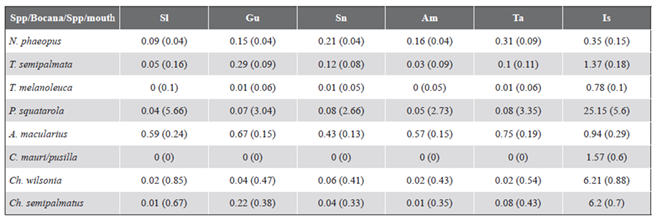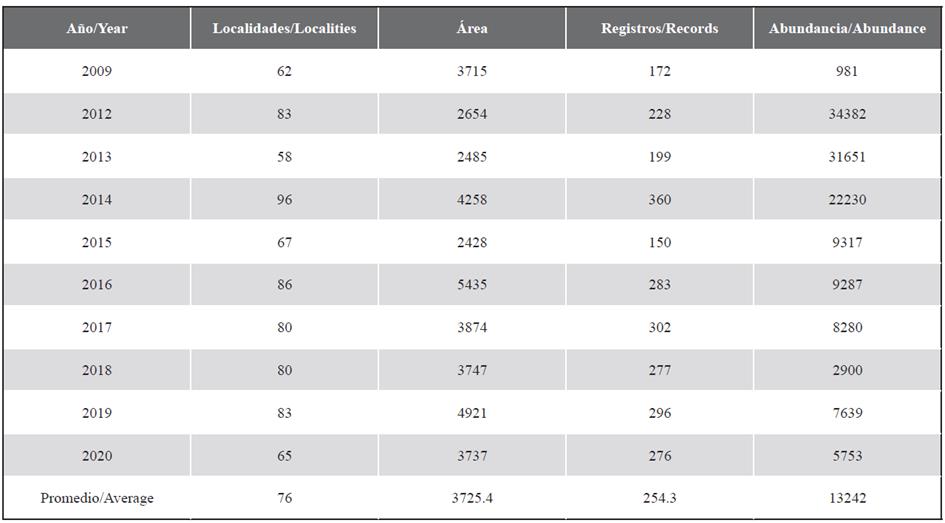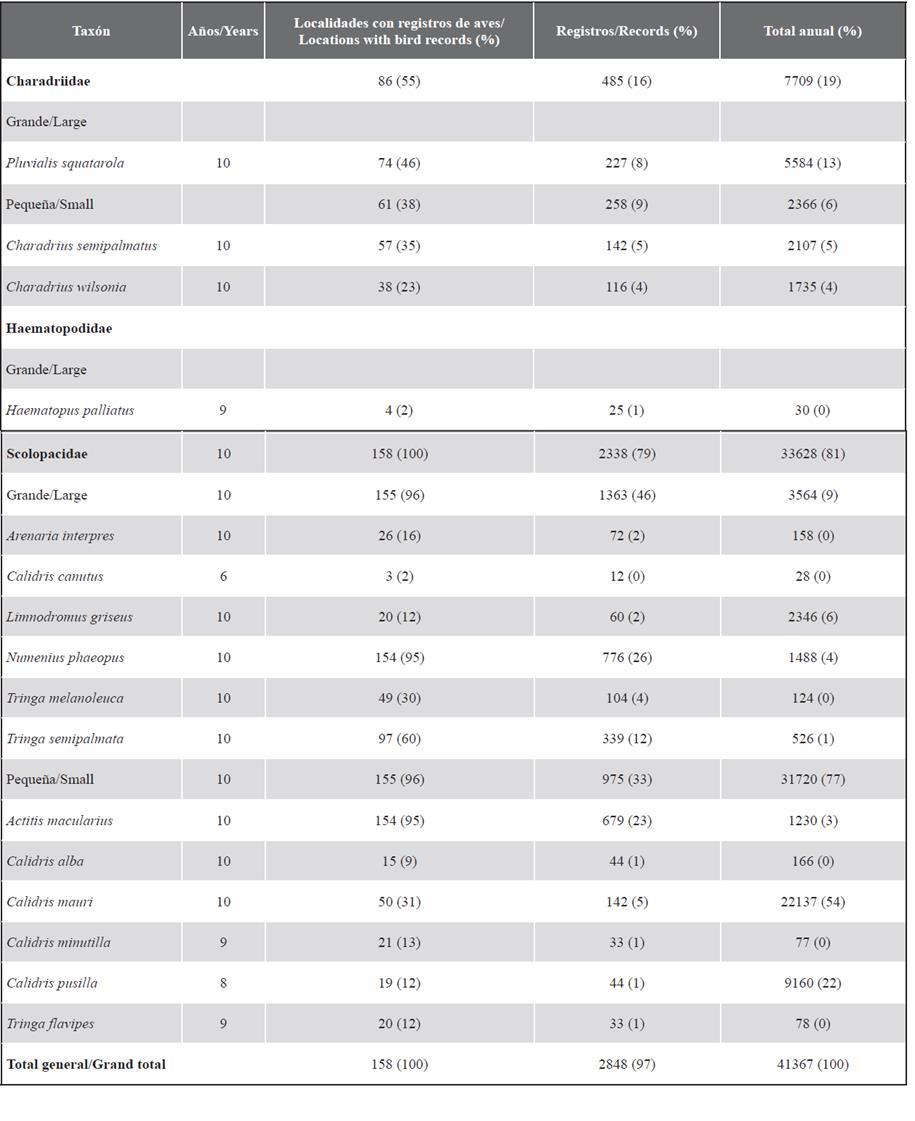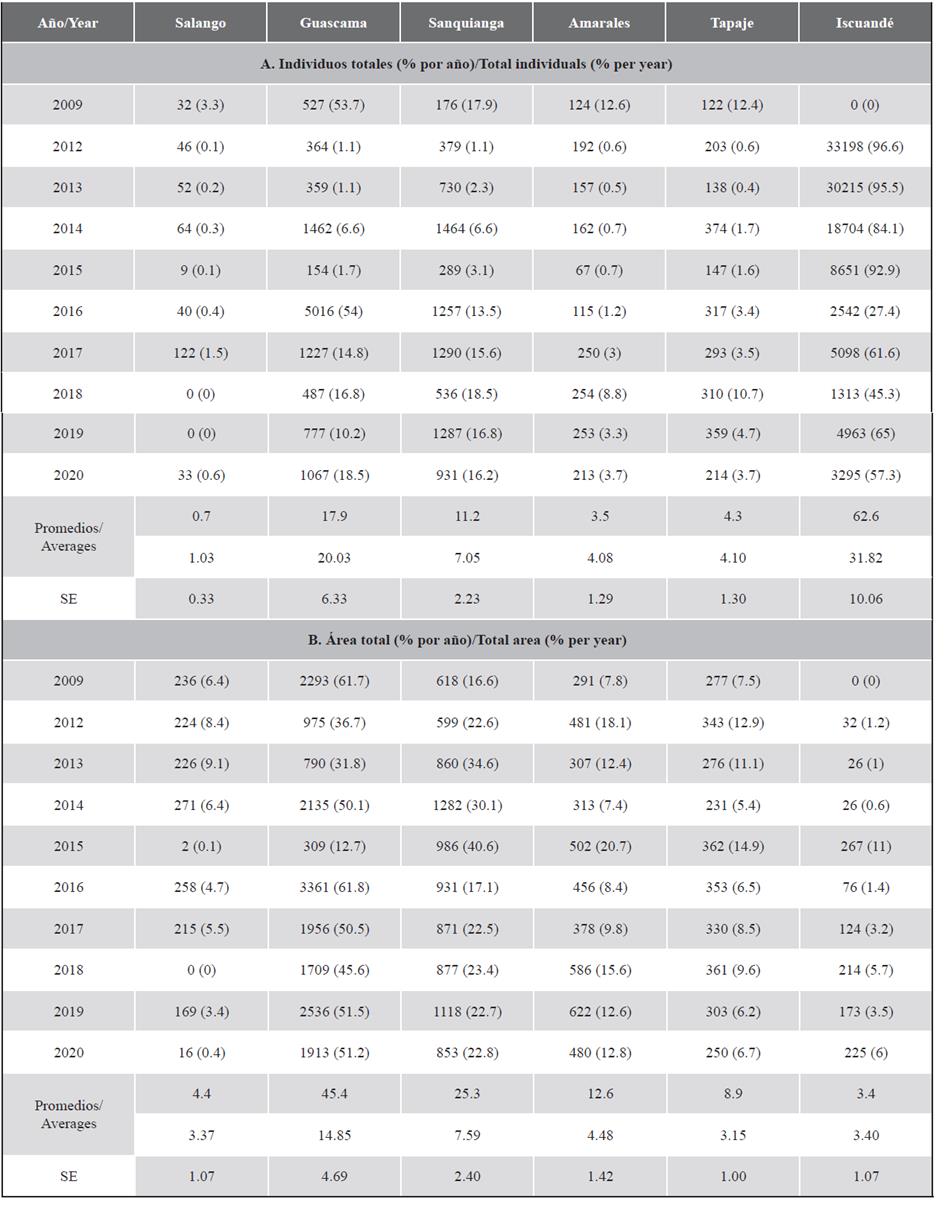INTRODUCTION
The north of the coast of Nariño is recognized as a site of great bird richness (Calderón-Leytón et al., 2011) and is home to two areas recognized for their importance for this group. The Sanquianga National Natural Park (SNNP), an important area for the conservation of birds (AICA), and the mouth of Iscuandé (IS), a shorebird reserve of the Western Hemisphere Shorebird Reserve Network (WHSRN), are sites of importance for the conservation of shorebirds in the American Pacific flyway (Senner et al., 2017) and harbor the highest concentration of non-breeding shorebirds in Colombia (Johnston-González and Eusse-González, 2009a). Shorebirds are waterbirds that depend on wetlands at some point in their life cycle (Ruiz-Guerra, 2013). They are a very important faunal component in the mangrove region of northern Nariño (Calderón-Leytón et al., 2011), where 34 species have been recorded, 32 of them migratory (Ruiz-Guerra, 2011). For the study area, around 10 000 shorebirds are reported in a single counting event in the SNNP and a population of about 50 000 individuals is estimated in IS (Asociación Calidris, 2009; Johnston-González et al., 2010; Zamudio et al., 2013; Asociación Calidris and Sanquianga NNP (unpublished data). These large concentrations correspond to significant percentages (between 1 and 10 %) of the biogeographic populations of at least four species, Actitis macularius, Numenius phaeopus, Charadrius wilsonia, and Pluvialis squatarola (Ruiz-Guerra et al., 2007; Johnston-González and Eusse-González, 2009a, 2009b).
Despite its importance, the area faces various threats. The dynamics of the estuary-delta of the Patía-Sanquianga River has changed in the last 40 years as a consequence of the increase in the flow, the sedimentation in the channels, the effects of tidal waves, the El Niño phenomenon, and the increase in the level of the sea. In particular, the diversion of the Patía River in 1973 generated accelerated erosion and sedimentation processes on the coastline, alterations in estuarine ecosystems, the incursion of fresh water and sediment in the system, increasing the extension of the tidal flats (Restrepo and Cantera, 2011). Some effects of this “environmental collapse” are known (Parra and Restrepo, 2014), but the impacts on biodiversity associated with tidal flats are unknown, particularly on shorebirds.
Due to the environmental situation facing the region, in the Sanquianga National Natural Park Management Plan 2018-2023, tidal flats were selected as Conservation Objective Values (COV) (PNN Sanquianga, 2017), and were classified as conservation areas in the Zoning Agreement of the Esfuerzo Pescador Community Council, to which the IS belongs (Asociación Calidris and consejo comunitario Esfuerzo Pescador, 2017). To evaluate the progress of the SNNP and IS management agreements, since 2012 several elements of biodiversity have been monitored, including shorebirds in the tidal flats.
These monitoring programs were articulated with the American Pacific Migratory Shorebird Project (MSP), in which shorebird populations are monitored in their wintering area, which includes sites from southern Canada to Chile (Reiter et al., 2020). This program, which encompasses nearly 100 sites in the 13 countries along the American coast, contributes to the identification of multiple causes and rates of local and regional change in shorebirds (Butler et al., 2004). This is key considering that 11 % of shorebird populations in the American Pacific are in decline and an additional 46 % do not have enough data to estimate their population trend (Senner et al., 2017). Understanding the magnitude of these changes requires coordinated efforts to document the number and distribution of shorebirds, considering multiple spatial scales.
In this sense, the ecological differences that the species present must be considered to understand the spatial patterns that they present. For example, migratory distance and body size, among other factors, have been evaluated as determinants of the population decline of different species (Thomas et al., 2006). Small shorebirds, such as some species of the genus Calidris, present contrasting distribution patterns to larger birds (Kauffman et al., 2018). At least part of these differences could be associated with repertoires of anti-predatory strategies (Lank et al., 2003) that include, for example, the selection of safer habitats (Hope, 2018; Johnston-González, 2019) or the localized availability of specific resources such as biofilms (Jiménez, 2013). However, the effects of these ecological differences on the distribution patterns of birds of different sizes are unknown.
In the present study, the composition of the shorebird community in tidal flats of the SNNP and IS is described in relation to differences in body size; also, the spatial variation within the six mouths with the differential influence of the Patía-Sanquianga River is evaluated. The results of these analyzes will be useful to guide management actions in the territories and to have a baseline of the natural variability of the shorebird community associated with environmental changes in the study area.
STUDY AREA
The study area is located in the north of Nariño, on the southern coast of the Colombian Pacific (2° 40′-2° 23′ N and 78° 28′-77° 55′ W) (Figure 1). The region corresponds to the Sanquianga system, a delta complex in which the rivers Patía, Sanquianga, Satinga, Tapaje, Iscuandé, and other smaller courses converge (Alonso et al., 2008). In this complex, the mangrove forest occupies a wide strip that reaches 30 km in the SNNP as a result of the Patía-Sanquianga delta-estuary and is considered one of the most extensive in South America (Restrepo and Kettner, 2012). The area has a tropical climate, with average temperatures of 26 °C and abundant rainfall of between 3 000-3 500 mm, as it is located in one of the rainiest regions on earth (Fick and Hijmans, 2017). It has a semi-diurnal tidal regime that floods a large part of the area twice a day, with a monthly tidal height that reaches up to 4.6 m (IDEAM, 2016).
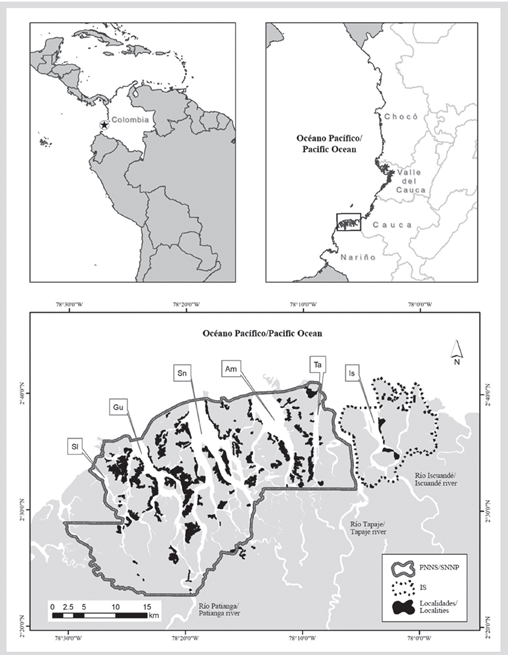
Figure 1 Study area. Location of the tidal flats in PNNS and IS in the Colombian Pacific: Sl = Salango. Gu = Guascama. Sn = Sanquianga. Am = Amarales. Ta = Tapaje. Is = Iscuandé.
The ecosystems of the SNNP and the IS comprise approximately 94,000 ha of coastal habitats (Asociación Calidris and consejo comunitario Esfuerzo Pescador, 2017; PNN Sanquianga, 2017), with mangrove forests, estuaries, mobile bottoms, sandy beaches, intertidal mud flats (Alonso et al., 2008) and human settlements.
This study focused on tidal flats, the main foraging habitat for shorebirds (Senner et al., 2017). These cover more than 12 000 ha on the north of Nariño coast (IDEAM et al., 2007; Murray et. al., 2019). They are recognized as one of the most important ecosystems in the area, by offering temporary resources that determine the behavior of the associated species and the supply of resources from other ecosystems (von Prahl and Cantera, 1990; Ruiz, 2004). They also stand out for being highly productive ecosystems (Murray et al., 2019) and an important habitat for feeding, refuge, and reproduction of waterbirds, especially for shorebirds (Johnston-González and Eusse-González, 2009a). Likewise, they are an important ecosystem for human communities that provide food and help to regulate coastal erosion in the region (Fundación Natura and Invemar, 2019).
The map of ecosystems of the area (Special Administrative Unit of the PNN System, 2007) was used for the SNNP, which reports 946 tidal flats (polygons), which occupy 10 190 ha (Alonso et al., 2008) in the five mouths of the SNNP. The mouths of the SNNP show differences in flow, delta width, sedimentation rate in the transverse channels, and retreat of the saline wedge in the river estuary. These differences between the mouths seem to be an effect of the Patía-Sanquianga River and range from a medium level in the Salango mouth to the west, high in the Guascama and Sanquianga mouths, and from medium to low in Amarales and Tapaje in the east of the SNNP (Parra and Restrepo, 2014). Additionally, about 2000 additional ha of this habitat are found in the IS, which was selected as a sixth mouth. In IS, the area of muddy planes is concentrated at the mouth of the river, where barrier islands are formed in constant change due to intense erosion by the effect of the sea and the sedimentation of Iscuandé River (Posada et al., 2009).
MATERIALS AND METHODS
To understand the behavior of the shorebird community within the SNNP and in IS, the area of influence of the six mouths was delimited on an ecosystem map of the sites and tidal flats were selected within each one. 155 tidal flats were selected in the SNNP and 7 in IS, as sampling locations (Figure 1). The selection and distribution of locations responded to the availability of sites in each entrance and ease of access (navigability and security). The fieldwork was carried out in 2009 and between 2012 and 2020 for a total of 10 years. Each locality was visited once each year between January 15 and February 15, a period in which migratory shorebird populations have become established in their non-breeding areas (Reiter et al., 2020). Each year between 58 and 96 localities were visited, covering between 17-30 % (2485-4258 ha) of the total habitat of the study area (14 000 ha) (Appendix 1). The counts were made from boats and only two localities in IS, the La Cunita and Quiñonez, were made on foot due to their great extension. Counts from boats were made two to three hours before and after low tide, while counts on foot were made two hours after high tide.
In SNNP, the counts were made during four consecutive days with maximum high tides between 3:00 and 5:00 h, while in IS, counts were made on two consecutive days with maximum high tides between 5:00 and 6:00 h. The selection of the time and tidal time sought to ensure that the exposure of the tidal flats is the maximum during the shorebird count, but that it allows navigation between the estuaries. In each locality, a count and identification of shorebirds were carried out and characteristics of each locality were recorded, such as the state of flooding, and the proportion of the visible habitat. Other habitat variables (presence and height of vegetation) and climate (cloudiness and precipitation) were recorded following the recommendations of the MSP project (Reiter et al., 2020).
To reduce biases associated with the identification and counting of large flocks, only birds up to 200 m away from the observers were counted. For flocks of several thousand individuals, estimation (tens, hundreds, thousands) and repeated counting (sometimes with several observers) was necessary until consensus was reached. In the case of mixed flocks, a first estimate was made of the size of the flock and then of the percentages by species of several groups selected in the telescope or binocular field. Similar species such as Calidris mauri and C. pusilla can be distinguished with a combination of field markings, especially bill size (Pyle, 2008). However, in the mentioned situations (large and mixed flocks) it is not always easy to separate the species, so it was decided to unite them for the analyzes.
Composition of the bird community. To characterize the taxonomic composition of the shorebird community in SNNP and IS, the frequency was evaluated as the number of locations with records /total locations and the number of records/total records of all species and abundance of each species as the maximum annual value in the entire study area divided by the accumulated total of all species. The proportions of families and groups of species by size were compared using descriptive statistics.
Spatial variation of frequency. To identify if there are differences in the spatial distribution of shorebird species, the probability of registering each species among the six mouths that form the study area were compared. For each species, a mixed generalized linear model (GLMM) with binomial distribution was fitted. This model used the number of visits with records of the species to estimate the probability of presence (response variable) as a function of the river mouth (explanatory variable). The sampling location was used as a random variable nested within each mouth. The fit of the model was evaluated with the quotient of its statistical deviation divided by the statistical deviation of the null model (Ho: the mean probability of registering the species does not differ between mouths). To determine the significance of the test, the Z statistic and the Wald chi-test were used, and subsequent Tukey tests were performed to determine between which pairs of mouths there is evidence of a difference in the probability of the presence of each species.
Spatial variation of density. The spatial variation in abundance was evaluated using a linear model with density (individuals/ha) as the response variable and the mouth as the explanatory variable. Due to the scarcity of data for Salango, it was decided not to include this mouth in the analysis. Subsequent Tukey tests were performed to determine between which pairs of mouths there is evidence of a difference in the density of each species. The F statistic was used with a level of significance of P = 0.05. The models for frequency and density were implemented with the lsmeans package (Lenth, 2016) in the R statistical program (R Core Team, 2020).
RESULTS
Shorebirds were present in 158 out of 162 of the localities visited in the IS and SNNP count between 2009 and 2020. Scolopacidae was the most frequent family, with at least one record in all localities with shorebirds, while Charadriidae was recorded in little more than half of the localities and Haematopodidae in only four (Figure 2A). Large species contributed 55 % of the accumulated shorebird records in 10 counting years (Appendix 2). This contribution was greater in the families Haematopodidae and Scolopacidae than in Charadriidae (Figure 2B, Appendix 2). Three of the four most common species were large birds (N. phaeopus, T. semipalmata and T. melanoleuca) and together they contributed 42 % of all records accumulated in 10 years (Figure 2C, Appendix 2). Numenius phaeopus and Actitis macularius have the widest distribution (Figure 2C), present in 95 % of the localities visited while C. mauri and C. pusilla contributed two-thirds of the total annual abundance (Figure 2D). Together these results show that shorebirds are ubiquitous in the IS and SNNP coastal landscape since they occupy almost all intertidal habitat locations. Additionally, large birds have a greater distribution (more locations and accumulated records), while a few small bird species dominate numerically.
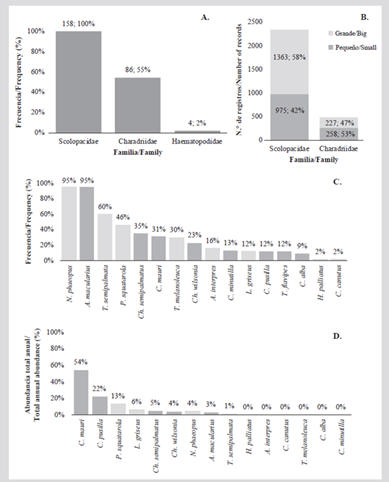
Figure 2 Frequency (proportion of localities with records), records, and abundance of shorebirds by family in PNNS and IS. A) Frequency by family. B) Records by family and size category (H. palliatus only species of Haematopodidae, only has 25 records and is not shown in the Figure). C) Frequency (%) by species. D) Maximum annual total abundance. In B), C) and D) the small species are represented with dark gray and the large ones with the lighter gray. See Annex 2 for absolute values and additional details.
Within the SNNP the contribution of abundance was proportional to its sampled area, contrary to what was observed in the mouth of Iscuandé, which contributed an average of 63 % of the annual abundance, 21 times more than expected for its sampled area, which is only 3.4 % of the total in the study area (Figure 3). The Sanquianga and Guascama mouths contributed an average of 29 % of the annual abundance and 70 % of the sampled area, while the remaining mouths (Amarales, Tapaje, and Salango) contributed the remaining 9 % with 26 % of the sampled area (Appendix 3).
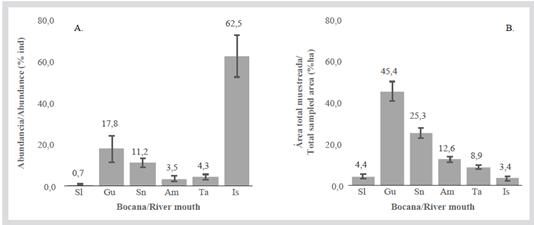
Figure 3 Contribution of each river mouth to A) Total abundance of shorebirds and B) Area sampled during 10 counting years. (The bars indicate the average and the lines a standard error). The data for each year are found in Annex 3. Mouths: Sl = Salango. Gu = Guascama. Sn = Sanquianga. Am = Amarales. Ta = Tapaje. Is = Iscuandé.
Differences were found in the composition by size categories between IS and SNNP. Within SNNP, the composition between large and small birds was similar, varying proportionally between 40 and 50%, while in IS, small birds predominated over large birds with 81% of the abundance (Figure 4A). Also in IS 87% of the abundance of large shorebirds was contributed by P. squatarola and L. griseus (Figure 4B), while 90% of small birds were contributed by C. mauri/pusilla (Figure 4C). On the other hand, in SNNP N. phaeopus contributed 65% of the abundance of large birds and A. macularius 55% of small birds. Additionally, the composition of the Guascama and Sanquianga mouths differs from the other mouths in SNNP, with a higher abundance of T. semipalmata and C. mauri/pusilla. Together these results show that the composition, measured as the percentage contribution to the total abundance, was very different between IS and SNNP and that in the latter the mouths with the greatest influence from Patía (Guascama and Sanquianga) present a slightly different composition from the rest of the park.
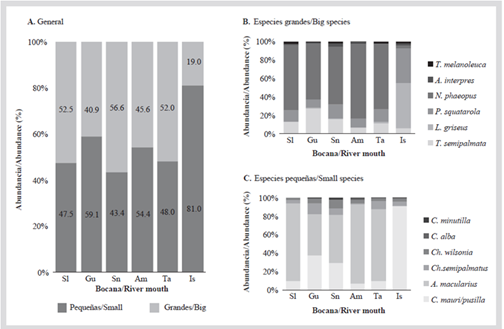
Figure 4 Proportion of abundance of common shorebird species by A)Size category and by species within each category (B and C). The darker colors indicate the less abundant species. Sl = Salango. Gu = Guascama. Sn = Sanquianga. Am = Amarales. Ta = Tapaje. Is = Iscuandé.
Six out of eight species had a higher probability of presence in the Iscuandé mouth (Figure 5), N. phaeopus had a similar probability in all the mouths, and A. macularia a lower probability in the Salango and mouth of Iscuandé. Within the SNNP the six species (T. semipalmata, T. melanoleuca, P. squatorola, C. mauri/pusilla, Ch. Wilsonia, and Ch. Semipalmatus) show differences between the mouths. In general, in the Guascama and Sanquianga mouths the probability of presence is higher for the six species, although only for T. semipalmata the difference between these mouths is significant. Charadrius wilsonia has a significantly lower than average probability of presence. Table 1 shows the average values of the probability of presence with its standard error of the eight species.
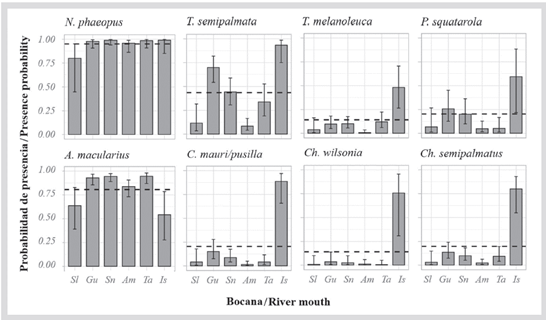
Figure 5 Spatial variation in the probability of the presence of eight species of shorebirds in five mouths of the PNNS (Sl = Salango, Gu = Guascama, Sn = Sanquianga, Am = Amarales, and Ta = Tapaje) and IS (Iscuandé). The points represent the average of each mouth and the bars the 95% confidence intervals. The dotted line and the number below each species is the global average probability of occurrence for the entire study area.
Table 1 Average probability and standard error (SE) of the presence of eight species of common shorebirds in five mouths of the Sanquianga National Natural Park (Sl = Salango, Gu = Guascama, Sn = Sanquianga, Am = Amarales, and Ta = Tapaje) and the mouth of Iscuandé (Is).

Regarding density (Figure 6, Table 2), six species (T. semipalmata, T. melanoleuca, P. squatorola, C. mauri/pusilla, Ch. wilsonia, and Ch. semipalmatus) have a significantly higher density in the mouth of Iscuandé, while in the mouths of the SNNP the density is lower than average. Numenius phaeopus and A. macularius do not show significant differences in the six mouths studied, although the latter does show a higher density than the average in the Tapaje mouth.
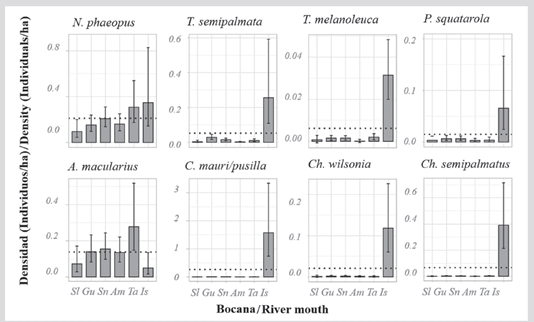
Figure 6 Spatial variation in the density of eight species of shorebirds in five mouths of the SNNP (Sl = Salango, Gu = Guascama, Sn = Sanquianga, Am = Amarales, and Ta = Tapaje) and IS (Iscuandé). The points represent the average of each mouth and the bars the 95 % confidence intervals. The dotted line and the number below each species is the overall average density for the entire study area.
DISCUSSION
The conservation of migratory species requires sets of sites that can offer habitat for multiple species (Senner et al., 2017). 10 years of counting at two important sites in the Pacific Americas Flyway: the Sanquianga National Natural Park and the mouth of Iscuandé River show that although they are contiguous basins, the composition of shorebirds in these two sites is very different. Six out of eight common species had a higher probability of being recorded and a higher density in Iscuandé, while the remaining two species, A. macularius and N. phaeopus, had a higher probability of presence and density within the SNNP. In addition to species turnover, the accumulated abundance of shorebird individuals showed a greater contribution from small birds in Iscuandé, mainly Calidris mauri and C. pusilla. These results show that SNNP and IS offer habitat for communities composed of different shorebird species and sizes and that their role in site conservation would be complementary.
Other studies have also found differential patterns for the spatial size distribution of this group of birds. For example, in the Bay of Panama, the species of the genus Calidris tend to be concentrated in the outermost sectors of the Bay (Kauffman et al., 2018), while large birds may occupy areas closer to the mangrove. The results of the present study suggest that these patterns of differential distribution of small species are also met in the north of Nariño with a more equitable distribution of large and small birds in SNNP and predominance of small birds in IS. The differences in the composition of the shorebird community between PNSS and IS can be caused by multiple factors, including those specific to the life history of species, including their size, feeding mode, and vulnerability to predators (Johnston-González, 2019) and habitat conditions, in particular the size of the sites and availability of resources in the habitat (Jiménez, 2013), the risk of predation (Martins et al., 2015; Hope, 2018), and its proximity to the ocean (Martínez-Curci et al., 2015). For example, during post-breeding migration, Calidris mauri selects areas with less proximity to vegetation (Hope, 2018), something that is interpreted as selecting the area with the lowest risk of predation. In this sense, the predominance of small shorebirds in IS could be the result of the selection of large localities, of more than 500 ha, that offer a greater contiguous area of habitat and concentration of resources in the same place as well as less vulnerability to predators. These conditions may attact the flocks of birds such as those formed by the small species of Calidris.
Although it was not quantitatively evaluated, the greater geographic proximity of the tidal flats to the coastline in Iscuandé presents greater marine influence, while within the PNN, with localities up to 30 km upriver, present a more estuarine and even freshwater influence. The influence of the type of habitat and its proximity to the ocean is one of the major factors that explain the differences in the distribution of shorebirds in other tropical locations (Ribeiro et al., 2004; Martínez-Curci et al., 2015). Although it is beyond the scope of this study, it is important to understand the interannual and multiyear temporal patterns of the shorebird community. However, the series of data analyzed in this study shows a natural variation of the bird community in the northern region of Nariño, which can be an input to define the population thresholds required to evaluate the effectiveness of management of the protected area (PNN Sanquianga, 2017), or the conservation achievements of the Mangrove Agreement (Asociación Calidris and consejo comunitario Esfuerzo Pescador, 2017).
Within the SNNP, the influence of the mouth of the Patía-Sanquianga river has caused changes in the hydrology and sedimentation rate of the mouths for more than 30 years (Parra and Restrepo, 2014). Morphological analyzes show that in the Sanquianga and Guascama mouths greater flow and sediments from the river are mobilized and that the saline intrusion in the estuary is lower due to the advance of the river towards the coast, producing significant hydric and ecosystem alterations, while the conditions of the Amarales mouth have remained stable in this same period (Parra and Restrepo, 2014). The results of the present study indicate a differential pattern in the taxonomic composition and by size categories of shorebirds in the mouths with the greatest influence of the Patianga. However, the prediction of differences in the distribution and abundance of central-western sectors (Guascama and Sanquianga) was not supported by the data on the probability of presence and density of large or small birds. An exception is Tringa semipalmata, which presented a high occupation of tidal flats in the Sanquianga and Guascama mouths. According to Reiter et al. (2020), this species has also increased its distribution in other areas of the American Pacific.
The marine-estuarine gradient can also influence the behavior of shorebird communities. In the case of the SNNP, this gradient extends for 30 km towards the continent and can include planes with a marine, estuarine or continental influence. In IS, the tidal flats are located directly on the coastline or a few kilometers (< 5 km) from it (MADS et al., 2015), for which a greater marine influence was assumed. This influence could cause differences in the composition of sediments, contributions of organic matter, and ultimately, different benthic communities that inhabit them and make up the diet of shorebirds. In particular, species of the genus Calidris spp. that feed on biofilms (Kuwae et al., 2012), a localized distribution resource, which is a limiting factor for the distribution of species.
The complementarity of the areas shows a size gradient in feeding sites, proximity to mangrove patches, and to towns, among others, which could provide a useful gradient for studies on the factors that condition the behavior of the composition and temporal distribution and space of this community of birds. Among these factors, the effect of proximity to vegetation or barriers that may obstruct surveillance of the surroundings (Ydenberg et al., 2002; Pomeroy et al., 2008; Martins et al., 2015) and the differential response of species according to their size categories. Another interesting aspect for future studies is the use that is given to the sites in different temporal scales, such as throughout a day or in the stages of the migratory or reproductive cycle of shorebirds (Cifuentes-Sarmiento and Ruiz-Guerra, 2009).
CONCLUSIONS
This study documents the spatial variation of shorebird abundance over 10 years (2009, 2012-2020) in tidal flats in the extensive 1 000 km2 coastal landscape of northern Nariño, Colombia. The composition and abundance of shorebirds were very different between IS and PNNS, indicating the complementarity of these sites for habitat conservation. In the coastal and more marine planes of IS, small birds contributed more than 80% of the abundance, with C. mauri-pusilla dominating numerically. In the small planes surrounded by mangroves along the estuarine gradient of PNNS, abundance was distributed more evenly between small and large species, with A. macularia (small) and N. phaeopus (large) being the most frequent species and abundant. These differences on a regional scale could be explained by variations in the size and configuration of tidal flats, differences in the marine gradient and in food resources, as well as differences in the natural history of the species, factors that require further investigation. These results contribute to establishing the baseline on the spatial variability of shorebird abundance that can be used to monitor conservation target values such as tidal flats within the Sanquianga National Natural Park and mouth of Iscuandé. As part of coordinated monitoring on a hemispheric scale, the counts from the north of Nariño also contribute to the knowledge of the status of the populations of this group of birds on the American Pacific flyway.











 text in
text in 


